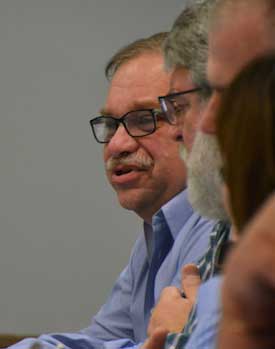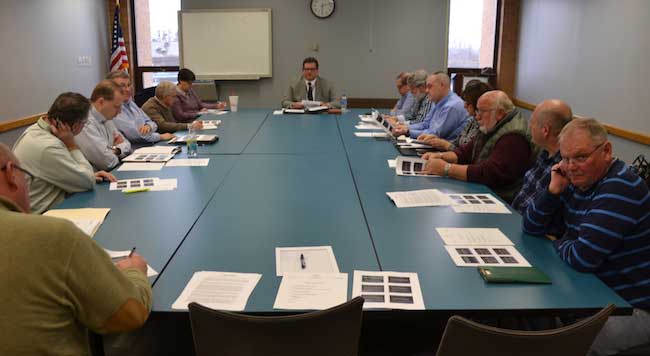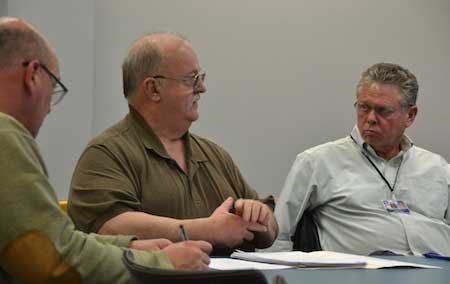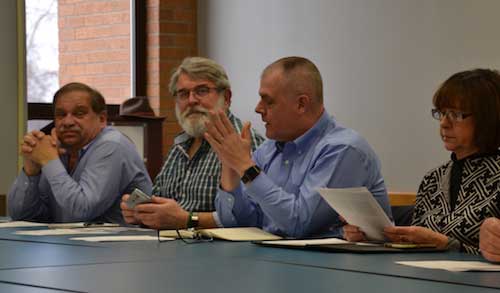Officials to consider countywide code enforcement, water services

Photos by Tom Rivers: Leaders of the town, village and county governments met Thursday to discuss shared services and possibly consolidating some functions. Brian Sorochty, mayor of Holley, said the village will be tackling water infrastructure soon. County Legislator Ken DeRoller, left, and Kendall Town Supervisor Tony Cammarata were among the participants in the discussion.
ALBION – Many of the leaders from village, town and county governments met Thursday to discuss shared services, and possible consolidation of some government functions including countywide code enforcement and water services.
The town supervisors, mayors and county legislators are making a list of potential changes in how local government services are provided. That may include sharing a grant writer, information technology services and buying electricity.
The group met for an hour and half on Thursday, and spent the most time discussing code enforcement. Many of the town and village codes officers are nearing retirement, and many only work part-time.
Moving the job to the county with a team of perhaps four full-time codes officers would likely increase availability of the code enforcement services and also allow some of the officers to specialize in tasks, with some reviewing plans and others doing inspections. Some could specialize in low-density housing or house-density housing, with another focused on lakefront development.
The 10 towns and four villages should also consider a uniform code so the municipalities don’t have different regulations, said Legislator Ken DeRoller of Kendall.

Medina Mayor Mike Sidari suggested looking at a shared grant writer and also information technology specialists.
“It’s a standardization and quality issue,” DeRoller said at the meeting at the County Administration Building. “Right now there are 14 different ways.”
The local officials met to discuss a shared services plan that needs to be submitted to the state later this year. First the plan needs to be presented to the County Legislature by Aug. 15, with public hearings to follow before the final plan is sent to the state by Oct. 15.
Gov. Cuomo has offered matching funds to local governments if they can share services or consolidate some functions. If those savings are quantified, the state will offer matching money, thus doubling the financial incentive.
Shifting code enforcement to the county level may not save money. In fact, it could cost more to replace several part-timers with full-time codes officers. The officials will calculate the current costs of all the current code enforcement officers, looking at salaries, fringe benefits and other expenses.
The concerns about costs ended the discussion about a decade ago when county-wide code enforcement was pushed by Richard Moy, the Clarendon town supervisor. But now officials are open to looking at how to improve the service.
“Having a unified system makes the county more attractive for development,” said Bob Miller, the Murray town supervisor.

Chuck Nesbitt, center, is the county chief administrative officer. He is leading the effort for a shared services plan that has to be submitted to the state by Oct. 15.
DeRoller said some economic development projects may be stalled or slowed due to the current code enforcement situation in the county. He said if there are added costs with a centralized code enforcement in the county, it would be worth it if it leads to more residential projects, more small business development and larger manufacturing projects.
DeRoller also wants to see more focus on 500 houses that he said are vacant in the county.
“People are dissatisfied,” he said about code enforcement. “We’re not consistent.”

Ron Vendetti, center, said the local municipalities should have standardized forms, setbacks and many regulations. He works as the codes officer for the villages of Albion and Holley, and the town of Murray.
Ron Vendetti works as the codes officer for the villages of Albion and Holley, and also the town of Murray. He said a unified code for the county would be well received by developers and the code enforcement officers. Vendetti is one of the codes officers nearing retirement. He noted that Wyoming County runs code enforcement through the county.
“Right now we have different levels of code enforcement throughout the county,” he said. “In some towns, there is a code enforcement officer for three hours a week. We could improve the quality and the standardization.”
If the job was moved to the county, it’s possible the duties could be handled through the Public Health Department, which already does public health inspections throughout the county.
Having a team of codes officers also might make the job less stressful for the codes officers, especially if they can specialize in different parts of the job. They would also have other colleagues to consult when interpreting the code.
In addition to code enforcement, the county and the town and village leaders will be looking at the current costs for providing water services. The county received a $50,000 grant to hire a consultant to review the 10 towns and four villages, looking at the water infrastructure and costs.
It’s possible a county water authority could be created to manage the water infrastructure. If the towns and villages were more united, it would help Albion and Lyndonville, which both have water plants, to secure financing for upgrades.

These officials include, from left, Medina Mayor Mike Sidari, Barre Town Supervisor Sean Pogue, Gaines Town Supervisor Joe Grube, and Albion Mayor Eileen Banker.
Chuck Nesbitt, the county chief administrative officer, said maintaining local control of the water plants is important for the entire county for future economic and residential development.
Lyndonville pumps about 400,000 gallons a day within the town of Yates. Albion pumps close to 2 million gallons and serves five towns, plus the village of Albion. The Monroe County Water Authority also supplies water in eastern Orleans and has locked Clarendon and Kendall into 40-year contracts. That has some officials in Orleans concerned the MCWA will push for more in-roads in the county.
Albion has an asset in the center of the county, Nesbitt said.
“It needs to be maintained and protected,” he said about the water plant. “How do we set this plant on its best foot going forward?”
The local officials will meet again 6 p.m. on May 3, and will compare their costs for information technology, grant writing, code enforcement and electricity, and look for ways to share services or perhaps consolidate the functions.





































































